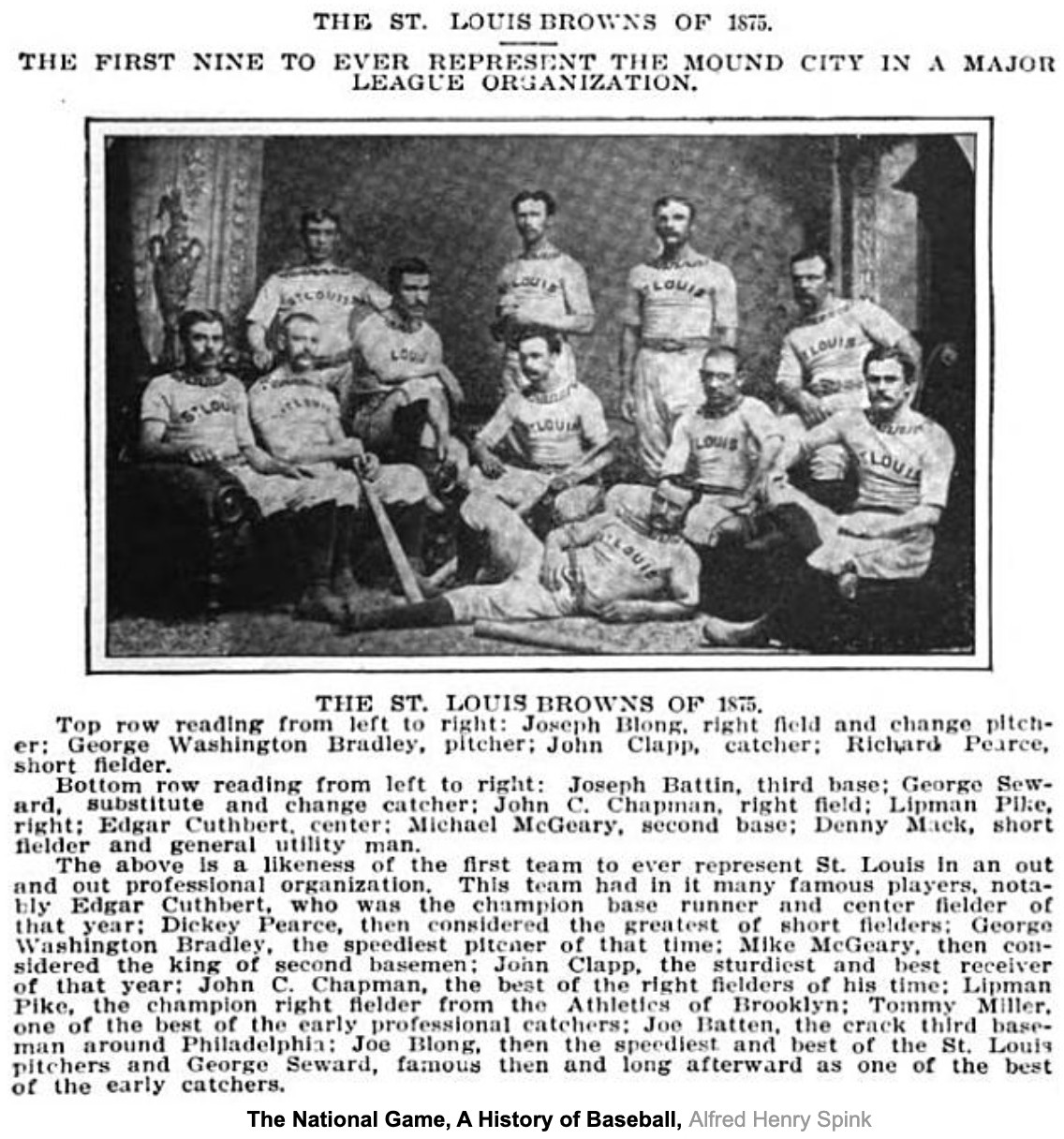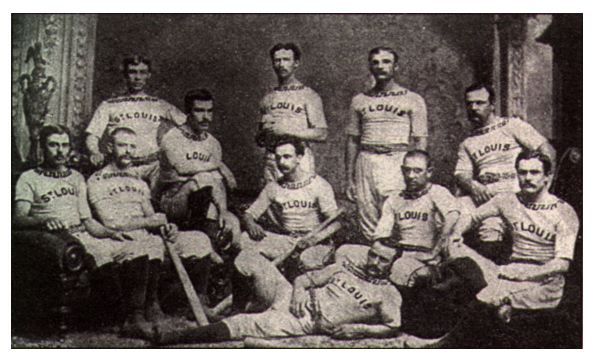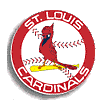St. Louis Brown Stockings
National Association (1875)
National League (1876-1877)
Roster
 In 1869, the Cincinnati Red Stockings, the first openly professional baseball club, toured
the country from coast to coast playing amateur clubs and compiling an undefeated record
for the season. The next summer, several more professional clubs were organized to challenge
them, including the Chicago White Stockings, who defeated the Red Stockings to claim the
title 'Champions of the West' for the 1870 season. In 1871, just two seasons after the Red
Stockings tour, the first all-professional league, the National Association, was organized;
the White Stockings were members of this organization. They and other Association clubs would
come to St. Louis and play the top local amateur clubs. The result was usually a lopsided
victory for the visitors. For example, from 1870 to 1874, the White Stockings won twenty
straight games over St. Louis clubs.
In 1869, the Cincinnati Red Stockings, the first openly professional baseball club, toured
the country from coast to coast playing amateur clubs and compiling an undefeated record
for the season. The next summer, several more professional clubs were organized to challenge
them, including the Chicago White Stockings, who defeated the Red Stockings to claim the
title 'Champions of the West' for the 1870 season. In 1871, just two seasons after the Red
Stockings tour, the first all-professional league, the National Association, was organized;
the White Stockings were members of this organization. They and other Association clubs would
come to St. Louis and play the top local amateur clubs. The result was usually a lopsided
victory for the visitors. For example, from 1870 to 1874, the White Stockings won twenty
straight games over St. Louis clubs.
In order to reverse this trend, a group of St. Louis leaders raised money in the fall of 1874
to organize a professional club to compete in the National Association in 1875. Among those
involved were J.B.C. Lucas II, one of the richest men in St. Louis, C. Orrick Bishop, a
prominent St. Louis lawyer, and Charles Fowle, who became the secratary of the St. Louis club.
Bishop stocked the team with players imported from the East Coast (causing some to grumble
about the lack of local boys on the club), and the St. Louis Brown Stockings joined the
National Association for the 1875 season.
The starters for the 1875 Brown Stockings, as signed by Orrick Bishop
| George Washington Bradley (P) played for an amateur club (Easton, Penn) in 1874 |
| Tom Miller (C) from the 1874 Philadelphia Athletics |
| Herman "Dutch" Dehlman (1B) signed from the 1874 Brooklyn Atlantics |
| Joe Battin (2B) from the 1874 Philadelphia Athletics |
| Bill Hague (3B) played for an amateur club (Easton, Penn) in 1874 |
| Dickey Pearce (SS) signed from the 1874 Brooklyn Atlantics |
| Edgar "Ned" Cuthbert (LF) from the 1874 Chicago White Stockings |
| Lipman Pike (CF) signed from the 1874 Hartford Dark Blues |
| Jack Chapman (RF) signed from the 1874 Brooklyn Atlantics |
On May 4th, the Brown Stockings opened the season playing the cross-town
Red Stockings (a successful local amateur club which joined
the National Association hoping to use its local roots to outdraw the imported Brown
Stockings) at their home field of Compton Park. The
Brown Stockings defeated their hosts 15-9 after carrying a 14-1 lead into the eighth inning.
Given the difference in experience between the two clubs, the outcome was hardly unexpected.
The first true test for the Brown Stockings came two days later against the Chicago White
Stockings, in the first professional game at the Grand Avenue
Grounds. The Browns Stockings defeated the Chicago club 10-0, with George Bradley
winning his second game of the season. The Brown Stockings defeated the White Stockings again
two days later, and St. Louis was sold on the club. Their record for the season was 39-29
record, good enough for 4th place; Bradley was credited with 33 of the teams 39 wins. While
they were 26.5 games behind the Boston team (which won 71 games while losing only 8), they
were just 8 games behind second place Hartford. The White Stockings finished the year at 30-37
in sixth place. During the season, the Brown Stockings auditioned two local players - George
Seward and Jim "Pud" Galvin. Seward played in the majors breifly in two other seasons, while
Galvin, who went 4-2 in his debut year, returned to the major leagues with Buffalo in 1879.
He finished his 14-year Hall-of-Fame career by returning to St. Louis in 1892.
Following the 1875 season, Fowle and Bishop were approached by William Hulbert, owner of the
Chicago White Stockings, with a proposal to form a new league. Their goal was to replace the
National Association with a stronger organization. The National Association was a loose
collection of teams; any interested club could join by paying the $10 entry fee at the start
of each season. There were no fixed schedules, so the teams arranged games with other memebers
on their own, and at the end of the season, the team with the most victories in these
'championship games' was awarded the pennant. Membership in the league fluctuated greatly over
its five year existance (1871-1875). Only three clubs played all five years (the Philadelphia
Athletics, the Boston Red Stockings (now the Atlanta Braves), and the New York Mutuals).
Furthermore the level of competition varied greatly, with huge gaps between the top and bottom
teams each year. This reached the extreme in the Association's final season, when Boston ran
away with the pennant. These problems and others plagued the National Association during its
entire existance. In addition, Hulbert had broken league policy during the 1875 season by
negotiating with several players under contract to other clubs. He figured out that the best
way to avoid the repercussions was to break away with the other top clubs. Hulbert and Fowle
recruited the clubs from Louisville and Cincinnati, and in early 1876, delagates from these
four clubs and four eastern clubs (Hartford, Boston, New York and Philadelphia) met in
Louisville and established the National League of Professional Baseball. Orrick Bishop wrote
the constitution for the new league, and on February 2, 1876, the National League was officially
in business. The birth of the National League spelled the end of the National Association. The
best clubs from the Association were included in the new organization, and the withdrawl of
those clubs from the Association weakened it both financially and on the field. The Association
collapsed before the 1876 season started.
In 1876, the first year of the National League, the Brown Stockings fared better than the year
before, finishing 45-19 in second place (6 games behind first place Chicago). Bradley was
 responsible for all 45 victories (and all 19 losses). One of his wins was the first no-hitter
in the NL, against Hartford on July 15, 1876. St. Louis won the season series from the Chicago
club, and so proclaimed itself the 'Champions of the West', as the White Stockings had done
the season before after besting the Brown Stockings for the year. To decide the matter on the
field, an unofficial post-season series was arranged between the two clubs, starting on October
5th in St. Louis. The two clubs split the first two games at the
Grand Avenue Grounds as Chicago star Al Spalding and St. Louis' Bradley traded shutouts.
The Brown Stockings won game three in Chicago 3-2 as a result of sloppy Chicago fielding. In
game four, Spalding and Bradley finally tired, and the Brown Stockings won a 21-18 game
featuring 43 hits and 32 errors. The victory clinched the series for the Brown Stockings, but
game five was played anyway in Milwaukee. The Browns Stockings won that game 16-15 (28 more
hits and another 32 errors) to decisively claim the Western Championship.
responsible for all 45 victories (and all 19 losses). One of his wins was the first no-hitter
in the NL, against Hartford on July 15, 1876. St. Louis won the season series from the Chicago
club, and so proclaimed itself the 'Champions of the West', as the White Stockings had done
the season before after besting the Brown Stockings for the year. To decide the matter on the
field, an unofficial post-season series was arranged between the two clubs, starting on October
5th in St. Louis. The two clubs split the first two games at the
Grand Avenue Grounds as Chicago star Al Spalding and St. Louis' Bradley traded shutouts.
The Brown Stockings won game three in Chicago 3-2 as a result of sloppy Chicago fielding. In
game four, Spalding and Bradley finally tired, and the Brown Stockings won a 21-18 game
featuring 43 hits and 32 errors. The victory clinched the series for the Brown Stockings, but
game five was played anyway in Milwaukee. The Browns Stockings won that game 16-15 (28 more
hits and another 32 errors) to decisively claim the Western Championship.
At the conclusion of the season, Philadelphia and New York were expelled from the league for
not completing their final western trips, dropping the league to six teams. Bradley joined
the Chicago club for the 1877 season, and Lipman Pike, the club's top offensive player in 1876,
signed with Cincinnati for 1877. Without their top players, the Brown Stockings slipped to
28-32 and 4th place in the six-team league.
(The Chicago team finished fifth in 1877 at 26-33, with Bradley going 18-23. After winning 78
games in his first two seasons in St. Louis, he would only win 60 more during a career of eleven
years as he switched between pitching and various other positions. The Cincinnati club placed
sixth, although Pike lead the league in home runs.)
Season-by-season statistics for the St. Louis Brown Stockings
1875 Brown Stockings statistics
1876 Brown Stockings statistics
1877 Brown Stockings statistics
Following the 1877 season, four players from the Louisville club were banned from baseball for
throwing games late in the season to allow Boston to win the championship. The scandal broke just
after two of them were signed by St. Louis for the 1878 season. (Jim Devlin, the pitcher for
Louisville in 1877, won two exhibition games for St. Louis in October of 1877 against the
league champion Boston Red Caps right before the allegations were made public.) On November
1, 1877, William Spink published an article in the Globe-Democrat detailing efforts by players
on the Brown Stockings to throw games during the 1877 season. Further, it was alleged that games
had been thrown in 1876 as well, and that Bradley, Pike and Ned Cuthbert were allowed to leave
because they spoke up to management about the situation. As the rumors and stories progressed,
the St. Louis club revealed it was in debt from the 1877 season, complicating matters. The club
was unable to raise money for the 1878 season and folded. The Louisville and Hartford clubs also
folded, leaving the NL with only three clubs (in Boston, Chicago, and Cincinatti). It would be
four years before another major league club played in St. Louis, and almost ten before another
St. Louis club competed in the National League. In 1879, the Brown Stockings merged with the
Red Stockings to form the nucleus of the organization which
would give rise to the St. Louis Browns of the American Association.
Jeffrey Kittel at (This Game of Games) has a
post about Chris Von der Ahe that discusses the situation around the downfall of the Brown
Stockings.
The Brown Stockings played their home games at the Grand Avenue
Grounds, located at Grand Avenue and Dodier. Games were first played at this site by
amatuer teams as early as 1866, and the first enclosed park on the site was built by August
Solari in 1871. The Brown Stockings were the first of three different major league clubs to
play at this location before the Cardinals moved out in 1966. The
site remains used for baseball; a field belonging to the Herbert Hoover Boys and Girls Club
is now located where the park used to stand.
Season-by-season record
| Year | Won | Lost | GB | Place |
| 1875 (NA) | 39 | 29 | 26.5 | 4th out of 13 |
| 1876 (NL) | 45 | 19 | 6 | 2nd out of 8 |
| 1877 (NL) | 28 | 32 | 14 | 4th out of 6 |
| 3 yrs | 112 | 80 |
Back to Baseball in St. Louis
 In 1869, the Cincinnati Red Stockings, the first openly professional baseball club, toured
the country from coast to coast playing amateur clubs and compiling an undefeated record
for the season. The next summer, several more professional clubs were organized to challenge
them, including the Chicago White Stockings, who defeated the Red Stockings to claim the
title 'Champions of the West' for the 1870 season. In 1871, just two seasons after the Red
Stockings tour, the first all-professional league, the National Association, was organized;
the White Stockings were members of this organization. They and other Association clubs would
come to St. Louis and play the top local amateur clubs. The result was usually a lopsided
victory for the visitors. For example, from 1870 to 1874, the White Stockings won twenty
straight games over St. Louis clubs.
In 1869, the Cincinnati Red Stockings, the first openly professional baseball club, toured
the country from coast to coast playing amateur clubs and compiling an undefeated record
for the season. The next summer, several more professional clubs were organized to challenge
them, including the Chicago White Stockings, who defeated the Red Stockings to claim the
title 'Champions of the West' for the 1870 season. In 1871, just two seasons after the Red
Stockings tour, the first all-professional league, the National Association, was organized;
the White Stockings were members of this organization. They and other Association clubs would
come to St. Louis and play the top local amateur clubs. The result was usually a lopsided
victory for the visitors. For example, from 1870 to 1874, the White Stockings won twenty
straight games over St. Louis clubs. responsible for all 45 victories (and all 19 losses). One of his wins was the first no-hitter
in the NL, against Hartford on July 15, 1876. St. Louis won the season series from the Chicago
club, and so proclaimed itself the 'Champions of the West', as the White Stockings had done
the season before after besting the Brown Stockings for the year. To decide the matter on the
field, an unofficial post-season series was arranged between the two clubs, starting on October
5th in St. Louis. The two clubs split the first two games at the
responsible for all 45 victories (and all 19 losses). One of his wins was the first no-hitter
in the NL, against Hartford on July 15, 1876. St. Louis won the season series from the Chicago
club, and so proclaimed itself the 'Champions of the West', as the White Stockings had done
the season before after besting the Brown Stockings for the year. To decide the matter on the
field, an unofficial post-season series was arranged between the two clubs, starting on October
5th in St. Louis. The two clubs split the first two games at the 


